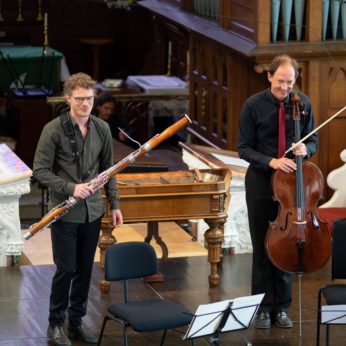Composer: Wolfgang Amadeus Mozart (b. 1756 - d. 1791)
Performance date: 08/07/2018
Venue: St. Brendan’s Church
Composition Year: 1775
Duration: 00:11:24
Recording Engineer: Ciaran Cullen, RTÉ
Instrumentation Category:Duo
Instrumentation Other: bn, vc
Artists:
Bram Van Sambeek -
[bassoon]
Christopher Marwood -
[cello]

74. COFFEE CONCERT – ST BRENDAN’S CHURCH 11.00
Bram van Sambeek [bassoon]
Christopher Marwood [cello]
Wolfgang Mozart [1756-1791]
Sonata for Bassoon and Cello in B flat K.292 [1775]
1. Allegro
2. Andante
3. Rondo: Allegro
In early 1772, Hieronymous Colloredo, the Prince Archbishop of Salzburg, offered Wolfgang Mozart, then aged sixteen, part time salaried employment as a violinist in the Court orchestra. Wolfgang was to be based in Salzburg until his final split with Colloredo in 1777. These were, largely, five years of frustration for Mozart. He was no longer the precocious child star who, with his sister, had charmed and astonished the crowned heads of Europe. He was now seeking to make his own reputation as a mature performer and composer.
What we now call classical music was largely a reaction to the ornate and often serious style of the baroque. Outside the church, classical music tended to be light, charming; often delightful. This style was called gallant then and we would call it easy listening now. Mozart could and did compose almost endless quantities of delightful music in the gallant style, but his ambitions demanded more. And in Salzburg, there was no demand for more. The Prince Archbishop wanted to reform the liturgy and shorten the mass. Hence Mozart wrote a number of Missae Breves for the church and a quantity of divertimenti, marches and serenades for the Court.
To escape the tedium of Salzburg, Mozart undertook a number of journeys with his father to Vienna, Milan and Munich. These attempts to find the young Mozart a superior position were notably unsuccessful. Indeed the Mozarts appear to have irritated some of the most powerful. The Empress Maria Teresa wrote to her son, the Archduke, Governor of Milan, warning him not to employ the “young Salzburger”. “You have no need of composers or useless people…furthermore he has a large family”. Even though Mozart did not have a large family, the Archduke did not employ him.
It was on one these trips, in this case to Munich in 1774-5 that Mozart probably met Thaddaus von Durnitz who was a pianist and bassoonist and it was he who probably commissioned this duo for Bassoon and Cello. Very little is known for certain about K.292. There is no signed manuscript which would definitively prove that it is by Mozart. It is certainly in his gallant style and bears certain resemblances to the earlier Bassoon Concerto. The combination of bassoon and cello is not quite as rare as you might think. Composers as diverse as Vivaldi and Hindemith composed for this combination. In the case of Mozart’s Duo, the cello part is essentially a base line which could be taken by a piano or even by another bassoon. The Duo could be a reduction of another bassoon concerto which may have been commissioned by von Durnitz but which has since been lost.
The first two movements are in sonata form. In both cases the development begins by repeating the phrase that concludes the opening statement. This repeats a device from the Bassoon Concerto. The slow movement is a melancholy aria for the bassoon. The last movement is a full scale rondo; each episode containing more and more witty bassoonery. The whole work is (of course) hugely delightful.
David Winter
Copyright © 2024 West Cork Music. All rights reserved.
Designed and developed by Matrix Internet